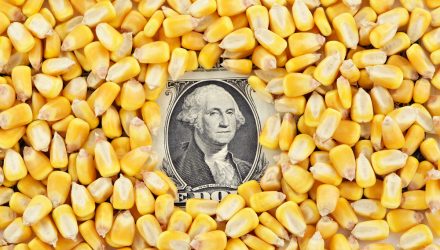A U.S. drought is providing the push for corn to go higher. However, the pull of a Brazilian surplus is balancing out prices for the commodity.
A Gro Intelligence article noted that the U.S. is experiencing a drought not seen in over a decade, providing an impetus for corn prices to push higher. When that happened in 2012, corn yields in the U.S. fell 20% lower than the previous five-year average. Production fell to 14% below average. This was the catalyst for corn futures pushing 40% higher in the latter half of that year.
Fast forward over 10 years, and this year is painting a similar picture. In addition, a high inflation environment is already giving consumers a gut punch in rising food prices.
“This year, drought is once again hitting the Corn Belt, as seen in this Gro display. Gro’s US Corn Yield Forecast Model is currently predicting yield will be more than 5% below the five-year average and more than 10% lower than last year,” Gro Intelligence reported. “Corn crop conditions, although slightly higher in the latest week, are also well below average levels in most corn growing states, especially in top producers Illinois and Iowa.”
Countering that is Brazil’s surplus. Gro Intelligence reported that the largest Latin American economy is set to produce a record 132 million tons in 2023 to 2024. This equates to a production number 35% above the five-year average. It is also 81% higher than similar production back in 2012.
This surplus has allowed Brazil to form a supply agreement with China, according to a Reuters report. Given this, Brazil is challenging the U.S. for its position as the top corn exporter.
“When we look at U.S. corn demand long term, we wonder where new demand is coming from,” said Stephen Nicholson, global grains and oilseeds sector strategist with Rabobank, an agricultural lender.
“Brazil is likely taking a bigger share of the global market, ethanol has likely peaked and animal protein is likely not going to grow fast enough,” he said.
Trade or Invest in This Corn ETF
As the combination of climate and geopolitical forces continue to shape the direction of corn prices, investors can get exposure in the commodity via exchange traded funds (ETFs). Whether for trading short-term price action or as a long-term investment, consider the Teucrium Corn Fund (CORN).
The fund tracks three futures contracts for corn traded on the Chicago Board of Trade. It includes 35% second to expire contracts, 30% third to expire contracts, and 35% December following the third to expire. The various contract exposures help the fund limit the negative effects of rolling contracts, especially during a market in contango.
For more news, information, and analysis, visit the Commodities Channel.

